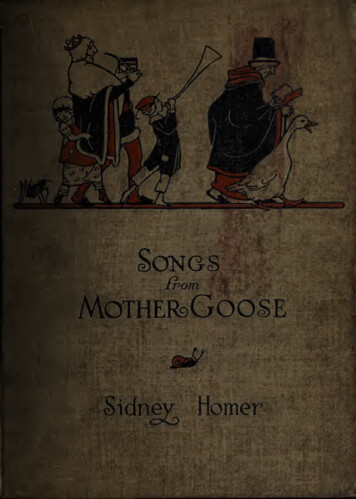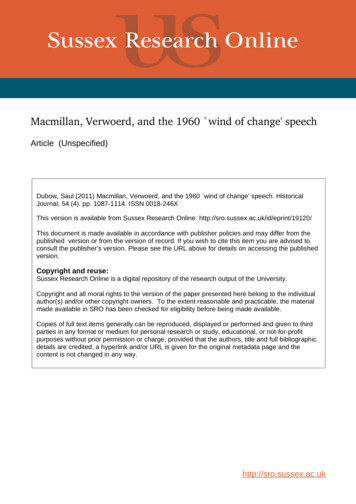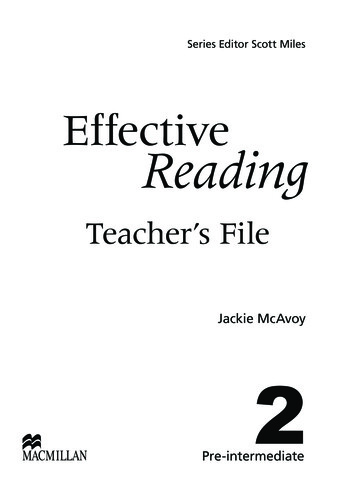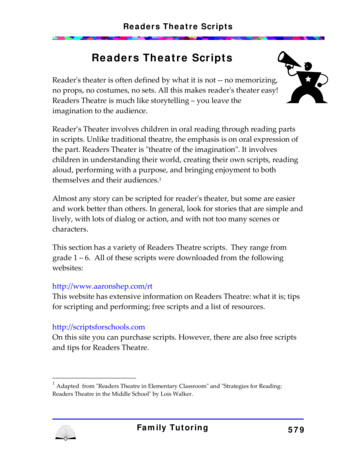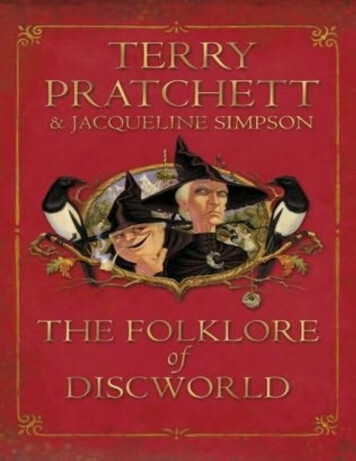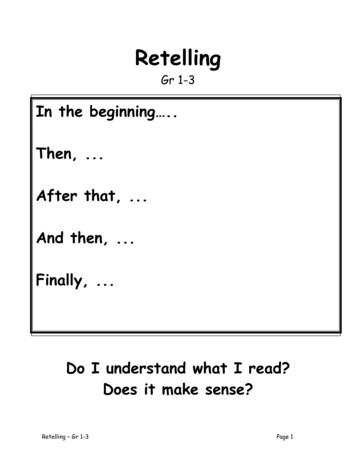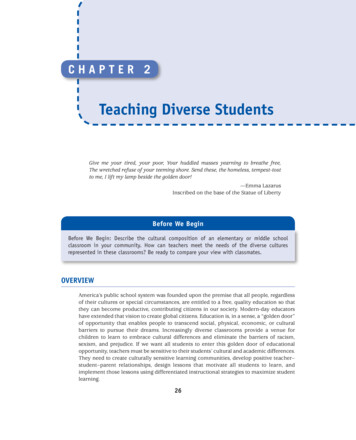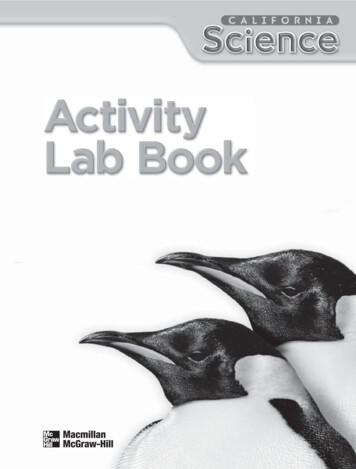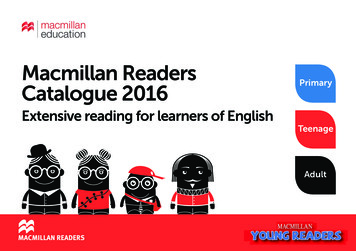
Transcription
Macmillan ReadersCatalogue 2016Extensive reading for learners of EnglishPrimaryTeenageAdult
HeadingLove to read.HeadingCELEBRATE SHAKESPEAREIN 2016Join in the global celebrations! We’ve gotlots in store to mark the 400th anniversary ofShakespeare’s death including: New lesson plans to accompany our sevenShakespeare Readers A Shakespeare-themed webinar day in April A creative writing competition for students Quizzes, infographics and videos2Sign up for emails and get a FREE Shakespeare eBook online anreaders.comWelcome to the wonderful world ofMacmillan Readers!From James Bond and Jane Eyre –to Shakespeare, short stories andnon-fiction; whether you’re teachingreluctant young readers or enthusiasticadults, we’ve got a Reader for you!If you’re looking for additional resourcesto help you bring language, dramaand literature to life in your classroom,be sure to join me on the MacmillanReaders website.Happy reading!Readers ManPS: Sign up for emails throughout 2016and you’ll get a FREE Shakespeare eBook!Macmillan Children’s Readers (pre-A1 – A2)4Macmillan English Explorers (pre-A1 – B1 )8Macmillan Explorers Phonics (pre-A1 – A1 )12Macmillan Factual Readers (A1 – B1 )14Macmillan Readers (A1 – B2)18Macmillan Cultural Readers (A2 – B2)42Macmillan Literature Collections (C2)44Macmillan eBooks46ISBNs and Contact Information483
PrimaryMacmillan Children’s ReadersMacmillan Children’s Readers re a colourful series for 6- to 12-year-olds andoffering a variety of fiction and non-fiction titles mapped to the CEFR andYoung Learners exams.They are fun, cultural and informative and reinforce the basic structures andvocabulary found in most primary courses.Children will love the exciting adventures and be captivated by the highly visualfact files. The series can be used as supplementary reading material alongside anyprimary course.SeriesMacmillan Children’s Readers50 titlesLevelLevel 1 – pre-StartersCEFR(Absolute beginner)Level 2 – Starters(Absolute beginner)Level 3 – Starters/MoversA1/A1 Level 4 – Starters/MoversA1 Level 5 – MoversA2Level 6 – MoversA2Key features A picture dictionary (or word list) and activity pages are included at the back of each Reader The blend of ‘Fact Files’ and topical fictional stories appeals to boys and girls equallyLevelsThe Macmillan Children’s Readers are a six-level series,suitable for children aged between 6 and 12.Online support Full audio downloads and Teacher’s Notes Free worksheets to accompany the books Guide to Using Graded Readers in the YoungLearner ClassroomUsing GradedReaders in theYoung ders4www.macmillanyounglearners.com/readers5
PrimaryMacmillan Children’s ReadersClothes We Wear/George’s Snow ClothesFun at the Beach/The Big WaveThe Wild West/The Tall Tale of Rex RodeoEdinburgh/Festival FearDo people in different countries wear different clothes?This fact and fiction Reader explores the clotheswe wear in everyday life, inside and outside, and atdifferent times of the year.What activities can you do at the beach? And whichanimals live in the sea? This fact and fiction Reader isabout having fun at the seaside.This fact and fiction Reader about the exciting WildWest deals with interesting topics such as the GoldRush, Native Americans, cowboys and more.24pp British English 978 0 2304 6920 4Availability: Worldwide32pp British English 978 0 2304 6923 5Availability: WorldwideEdinburgh is the capital of Scotland and it has a bigcastle. There are many famous buildings and places tosee and the Edinburgh Festival is famous! This fact andfiction Reader is the perfect guide to this exciting city.Joanna Pascoe24pp British English 978 0 2304 6919 8Availability: WorldwideLevel 1Level 5Level 2Big and Little Cats/Grandad’s Weekendwith LeoChocolate, Chocolate, Everywhere!/The Chocolate FountainThere are lots of different types of cats, both big andsmall. Some are wild and some are kept as pets. Manypeople like to keep cats. This fact and fiction Readertells you more about these interesting animals.Where does chocolate come from? And how is it made?There are lots of types of chocolate and many peoplelike eating chocolate. This fact and fiction Reader tellsyou all about this tasty snack.32pp British English 978 0 2304 6921 1Availability: Worldwide32pp British English 978 0 2304 6922 8Availability: WorldwideColeen Degnan-VenessLevel 3Paul MasonJoanna PascoePaul Mason32pp British English 978 0 2304 6924 2Availability: WorldwideLevel 6Paul MasonCaptivateyoung readerswith vibrantillustrations!Level 4pp number of pages in the book6www.macmillanyounglearners.com/readers7
PrimaryMacmillan English ExplorersThe Macmillan English Explorers are an eight-level series, supported by a fourlevel phonics scheme, suitable for children aged between 4 and 12.Each Reader is illustrated in full colour and contains one complete story. The storieshave been written using high-frequency words, plus story-specific words which asfar as possible are clarified by illustrations.Written specifically for young learners of English, this scheme has been informedby teaching methodology for first-language speakers of English. The Readers plussupplementary materials can be used alongside any primary course.SeriesMacmillan English Explorers50 titlesLevelCEFRExplorers A – Starters(Absolute beginner)Explorers B – Starterspre-A1Explorers 1 – StartersA1Explorers 2 – MoversA1 Explorers 3 – Movers/FlyersPre-A2/A2Explorers 4 – FlyersA2 Explorers 5 – Beyond FlyersB1/B1 Explorers 6 – Beyond FlyersB1/B1 Key features The rich variety of texts, from original fiction to legends,means any child can enjoy reading, wherever theirinterests lie The comprehension Workbooks develop a range ofreading skills while the Phonics Workbooks support thesystematic teaching of phonics Word-recognition skills are reinforced by the Workbooksand word cards in the Teacher’s Notes Cross-curricular content at higher levels means childrencan make links to other school subjects The stories promote social values such as friendshipand respectSupport materials Teacher’s Notes are available for free from the MacmillanYoung Learners website.They include page-by-page lessonnotes and ‘Comprehension Extra’ activities The accompanying audio is downloadable for free fromthe website and gives children the opportunity to listen tothe stories while they read the cmillanyounglearners.com/readers9
PrimaryMacmillan English ExplorersLittle Red Riding HoodPuss in BootsAlice’s Adventures in WonderlandAlex RaynhamLewis Carroll, retold by Gill MuntonGrandma is ill, and Little Red Riding Hood must go toher. A wolf sees her and wants to eat her. Who canhelp Red Riding Hood, and where is the real Grandma?John is very poor. He has no money and no food. Buthe has a very clever cat called Puss in Boots. With justa sack and some grain, Puss in Boots helps his friend.How does Puss in Boots do it?One sunny day, Alice follows a White Rabbit down arabbit hole and into Wonderland! Wonderland is avery strange place and lots of very strange people livethere. Alice has some wonderful adventures with theMad Hatter, the March Hare and the Cheshire Cat. Andshe even plays a game of croquet with the frighteningQueen of Hearts!Alex Raynham24pp British English 978 0 2304 6925 9Availability: Worldwide32pp British English 978 0 2304 6926 6Availability: WorldwideThrough the Looking GlassLewis Carroll, retold by Gill MuntonThe sequel, Through the Looking Glass, is alsoavailable as a Macmillan English Explorer!88pp British English 978 0 2304 6930 3Availability: Worldwide72pp British English 978 0 2304 6929 7Availability: WorldwideYoung Explorers 1Young Explorers 2Explorers 5The Ugly DucklingThe Jungle BookMother Duck has six ducklings. But one ducklingis very big, and he looks different from the otherducklings. Everyone says, “You are an ugly duckling!”One day he looks down into the water. What do youthink he sees?Little Mowgli lives in the jungle with wolves. But not allthe animals are happy. Baloo the bear and Bagheerathe panther teach Mowgli the laws of the jungle tokeep him safe.Gill MuntonGill Munton56pp British English 978 0 2304 6928 0Availability: Worldwide40pp British English 978 0 2304 6927 3Availability: WorldwideYoung Explorers 310Explorers 6Discover a wonderlandof reading resources onthe Macmillan Readerswebsite, including freelesson plans and games!Explorers anreaders.com/150-years-of-alice11
catch, match, ketchup and so on. There are a few sounds represented by four letters.Macmillan Explorers Phonics6Some letters and some digraphs are used for more than one sound. The letter S produces a/s/ sound in sing and a /z/ sound at the end of sings. The /ch/ digraph produces differentsounds in chip, school and chef.Phonics: learning the sounds of English6Phonics: learning the sounds of EnglishSegmenting is the skill of dividing words into individual sounds. It is the opposite ofSpoken English is made up of sounds – about 44 distinct sounds – which are called phonemes.SpokenEnglishis made upsounds –whenabout44 distinctsounds– whichare calledphonemes.blending.Segmentingis ofimportantlearningspelling.Thereare someunusualwordsThe phonics system is widely used in teaching reading to native English speaking children.Thethatphonicssystemisthewidelyusedin teachingto nativespeakingchildren.do notfollownormalphonicsrules. readingThese wordshaveEnglishto iting.TheMacmillanExplorersTeachers of English to EFL and ESL learners frequently use phonics in teaching reading.Teachers of English to EFL and ESL learners frequently use phonics in teaching reading.the Youngwebsite childrenyou can read howmore aboutthis in anoutarticleby Louis Fidge, ancomplement the first four levels of the Macmillan English Explorers in aOnwaythatReaderswill teachto soundwords,help young learners to understand and be able to use the complexities of EnglishPhonicsonhelpyoung phonics.learners to understand and be able to use the complexities of Englishexpertteachingblend o bespelling. Looking at the spelling of a word on a page is not always a secure guide to itsspelling. Looking at the spelling of a word on a page is not always a secure guide to itsused asa stand-alonephonicsscheme.pronunciation.Phonics helplearners toreadinghear what theysee.pronunciation. Phonics help learners to hear what they see.In phonics lessons, learners are taught three main skills: GPCs, blending and segmenting.Key featuresGPCs are Grapheme Phoneme Correspondences. They teach the basic sounds of English andthe ways in which they are written. Usually the first sounds pupils learn are s, a, t and p. The phonicsset withintheof a story to ensure thatLater they focuslearn andispractisemore vowelandcontextconsonant sounds.readingfor meaningretainedBlendingis the skill of isputtingtogether the individual sounds of a word in order topronounceit. S-i-s-t-er producessister. Manyof theof English donot correspond to Popularand gle letters. The sounds are produced by two letters together. These are called haractersareWe can think of digraphs like /sh/ or /ch/ or /ai/. Some sounds, called trigraphs, are writtenalso introducedas three letters, such as the last sound in the word /watch/. This /tch/ trigraph appears incatch,Teacher’smatch, ketchupNotesand so on.There howare a fewby fourletters. Detailedshowtosoundsfocusrepresentedon pellingSomeand somedigraphs are used forreadingmore than onesound.The letter S produces a/s/ sound in sing and a /z/ sound at the end of sings. The /ch/ digraph produces differentsounds in chip, school and chef.SupportmaterialsSegmentingis the skill of dividing words into individual sounds. It is the opposite of blending. Segmenting is important when learning spelling. There are some unusual wordsthat dodownloads,not follow the normalphonics rules. andThese wordshave to belearned areindividually.Full audioworksheetsTeacher’sNotesOn the Youngwebsite you canYoungread moreLearnersabout this inwebsitean article by Louis Fidge, anavailablefromReadersthe Macmillanexpert on teaching phonics. Big Books are available for some titles at the early levels12The chart below shows the titles in the Macmillan Phonics Readers and Phonics Workbook seriesand the sounds they focus upon.Explorers Phonics Readers and Workbooks, when used together, are an ideal programme forPhonicsfocusper levelintroducing and teachingphonics in a systematicand structured way.Phonics WorkbookPhonics ReaderPhonic focusLittle Explorers APhonics WorkbookIn Teddy’s Bagindividual letter sounds ‘a’, ‘b’, ‘c’, ‘d’, ‘e’ and ‘f’In Daisy’s BoxIn phonics lessons, learners are taught three main skills: GPCs, blending and segmenting.GPCs are Grapheme Phoneme Correspondences. They teach the basic sounds of English andthe ways in which they are written. Usually the first sounds pupils learn are s, a, t and p.Later they learn and practise more vowel and consonant sounds.Blending is the skill of putting together the individual sounds of a word in order topronounce it. S-i-s-t-er produces sister. Many of the sounds of English do not correspond tosingle letters. The sounds are produced by two letters together. These are called digraphs.We can think of digraphs like /sh/ or /ch/ or /ai/. Some sounds, called trigraphs, are writtenas three letters, such as the last sound in the word /watch/. This /tch/ trigraph appears incatch, match, ketchup and so on. There are a few sounds represented by four letters.Little Explorers BPhonics WorkbookSome letters and some digraphs are used for more than one sound. The letter S produces a/s/ sound in sing and a /z/ sound at the end of sings. The /ch/ digraph produces differentsounds in chip, school and chef.Segmenting is the skill of dividing words into individual sounds. It is the opposite ofblending. Segmenting is important when learning spelling. There are some unusual wordsthat do not follow the normal phonics rules. These words have to be learned individually.On the Young Readers website you can read more about this in an article by Louis Fidge, anexpert on teaching l/consonant words with ‘i’ (e.g.pin) and ‘o’ (e.g. box)The chart below shows the titles in the Macmillan Phonics Readers and Phonics Workbook seriesthe Mudconsonant/vowel/consonant words with ‘u’ (e.g.and the sounds they focus Inupon.mud)Explorers Phonics Readers and Workbooks, when used together, are an ideal programme forintroducing and teaching phonicsa systematicand structuredFish andinChipsconsonantdigraphsway.‘ch’ (e.g. chips), ‘sh’ (e.g.fish) and ‘th’ (e.g. bath, this)Phonics WorkbookPhonics Reader Phonic focusPin it onYoung Explorers 1Phonics WorkbookIn Teddy’sDaisyis Ill Bagindividual lettersounds‘c’,kiss),‘d’, ‘e’‘ck’and‘f’consonants‘ll’ (e.g.ill), ‘a’,‘ss’ ‘b’,(e.g.(e.g.duck), ‘ng’ (e.g. sing)individual letter sounds ‘g’, ‘h’, ‘i’, ‘j’, ‘k’, ‘l’ and‘m’In Daisy’sBoxCrazyCat andFat Old RatRun and Hideindividual letter sounds ‘n’, ‘o’, ‘p’, ‘q’, ‘r’, ‘s’and ‘t’Run and Hideindividualletter sounds‘h’, ‘i’, ‘j’, �l’ ‘l’ and‘m’ flag), consonant ‘r’ (e.g. grass), ‘s’ (e.g.consonant (e.g. stop), final consonant ��o’, ‘p’,‘q’, ‘r’, ‘s’(e.g.‘l’ consonanthelp),consonantand ‘t’ ‘s’ consonant (e.g. fast)hand),Look!individual letter sounds ‘u’, ‘v’, ‘w’, ‘x’, ‘y’ and ‘z’Teddy in Bedconsonant/vowel/consonant words with ‘a’ (e.g.bat) and ‘e’ (e.g. bed)Pin it onconsonant/vowel/consonant words with ‘i’ (e.g.pin) and ‘o’ (e.g. box)In the Mudconsonant/vowel/consonant words with ‘u’ (e.g.mud)Fish and Chipsconsonant digraphs ‘ch’ (e.g. chips), ‘sh’ (e.g.fish) and ‘th’ (e.g. bath, this)Daisy is Illconsonants ‘ll’ (e.g. ill), ‘ss’ (e.g. kiss), ‘ck’ (e.g.duck), ‘ng’ (e.g. sing)Crazy Cat andFat Old RatProfessor Greenand the SnakeThis page has been downloaded from www.macmillanenglish.com.Tom’s HaircutIt is photocopiable, but all copies must be complete pages. Macmillan Publishers Limited 2014.Young Explorers 2The MuddyLittle ExplorersYoungExplorersA1Phonics WorkbookPrimaryProfessor GreenLook!and the Snakelong vowel sounds with modifying ‘e’: ‘a-e’ (e.g.individual letter sounds ‘u’, ‘v’, ‘w’, ‘x’, ‘y’ and ‘z’lake), ‘i-e’ (e.g. hide)Tom’s HaircutTeddy in Bedlong vowel sounds with modifying ‘e’: ‘o-e’consonant/vowel/consonant words with ‘a’ (e.g.(e.g. note), ‘u-e’ (e.g. cute, blue)bat) and ‘e’ (e.g. bed)The MuddyPin it onSheep‘ai’ (e.g. rain), ‘ay’ (e.g. play), ‘ee’ (e.g. tree),consonant/vowel/consonant words with ‘i’ (e.g.‘ea’ (e.g. sea)pin) and ‘o’ (e.g. box)Daisy and theIn the MudBig, Yellow Kite‘y’ (e.g. fly), ‘igh’ (e.g. high), ‘oa’ (e.g. coat),consonant/vowel/consonant words with ‘u’ (e.g.‘ow’ (e.g. blow), ‘oo’ (e.g. moon)mud)Crazy Cat andFish and Chipsthe Stars‘ar’ (e.g. star), ‘er’ (e.g. ladder), ‘ir’ (e.g. bird),consonant digraphs ‘ch’ (e.g. chips), ‘sh’ (e.g.‘ur’ (e.g. turn), ‘or’ (e.g. torch)fish) and ‘th’ (e.g. bath, this)Pirate JackDaisy is IllLooks forTreasure‘oy’ (e.g. boy), ‘oi’ (e.g. point), ‘ow’ (e.g. down),consonants ‘ll’ (e.g. ill), ‘ss’ (e.g. kiss), ‘ck’ (e.g.‘ou’ (e.g. shout), ‘ea’ (e.g. head), ‘oo’ (e.g.duck), ‘ng’ (e.g. sing)look), ‘wh’ (e.g. wheel)initial consonant blends: consonant ‘l’(e.g. flag), consonant ‘r’ (e.g. grass), ‘s’ consonant (e.g. stop), final consonant blends:‘l’ consonant (e.g. help), ‘n’ consonant (e.g.hand), ‘s’ consonant (e.g. fast)Crazy Cat andFat Old Ratinitial consonant blends: consonant ‘l’(e.g. flag), consonant ‘r’ (e.g. grass), ‘s’ consonant (e.g. stop), final consonant blends:‘l’ consonant (e.g. help), ‘n’ consonant (e.g.hand), ‘s’ consonant (e.g. fast)long vowel sounds with modifying ‘e’: ‘a-e’ (e.g.lake), ‘i-e’ (e.g. hide)Professor Greenand the Snakelong vowel sounds with modifying ‘e’: ‘a-e’ (e.g.lake), ‘i-e’ (e.g. hide)This page has been downloaded from www.macmillanenglish.com.long vowelsounds with‘o-e’pages.It is photocopiable,but all modifyingcopies must be ‘e’:completePublishers Limited 2014.(e.g. note), ‘u-e’ (e.g. Macmillancute, blue)‘ai’ (e.g. rain), ‘ay’ (e.g. play), ‘ee’ (e.g. tree),Little Explorers BPhonics WorkbookYoung Explorers 2Phonics WorkbookYoung Explorers 1Phonics Workbooklong vowel sounds with modifying ‘e’: ‘o-e’Tom’s Haircutwww.macmillanyounglearners.com/readers(e.g. note), ‘u-e’ (e.g. cute, blue)Young Explorers 2The Muddy‘ai’ (e.g. rain), ‘ay’ (e.g. play), ‘ee’ (e.g. tree),1913
PrimaryMacmillan Factual ReadersMacmillan Factual Readers are a six-level series allowing learners of English to explore a variety of fascinatingreal-world topics. Beautifully designed with striking images, the Readers help learners build confidence in theirreading ability while enhancing their knowledge of subjects taught across the curriculum. The wide variety ofhigh-interest topics and the controlled use of vocabulary and structures make them the perfect CLIL Readers.SeriesLevelMacmillan Factual Readers40 titles14CEFR1 StartersA12 MoversA1 3 Movers/FlyersPre-A2/A24 Flyers/KETA2 5 PETB1/B1 6 PETB1/B1 www.macmillanyounglearners.com/readersKey featuresSupport materials The Readers use authentic language and important highfrequency words The lexis, grammar structures and concepts of the CLILclassroom are addressed within a motivating context inwhich to learn about different topics Subject-specific words are highlighted and explained in theglossaries Stunning photographs provide a visual context as well asclues to the more demanding lexis Fact boxes add interesting information which supports themain text Full audio downloads, worksheets and Teacher’sNotes are available from the Macmillan YoungLearners website Teacher’s Notes include photocopiable worksheetswith extra exercisesLevelsThe Macmillan Factual Readers are a six-level series (1 to 6 ).The plus ( ) sign indicates that, due to the focus on specialisedvocabulary and concepts, the language demands are morechallenging than standard Readers of the same level.15
PrimaryMacmillan Factual Readers16Levels 1 2 and 3 Levels 4 5 and 6 What do vets do? How do snakes get warm? And howdoes a train move? These and more questions areanswered in the lower-level titles of the MacmillanFactual Readers series.In the upper levels of the series, students can expectanswers to questions like: how do rainforests helpus to breathe? How do you win a Formula 1 race? Andwhat exactly is a star?Level 1 is a beginner level suitable for 6-year-olds whoare beginning to read. The Readers in Level 1 have beendesigned to use high-frequency words, repetition ofnew structures and vocabulary wherever possible, andvocabulary that is largely phonetically regular.Level 4 is a strong pre-intermediate (A2) level suitablefor 9- to 10-year-olds who are reading alone moreconfidently. In Level 4 , a variety of grammaticalstructures are used and there are more compoundsentences joined by colons and semi-colons.Level 2 is a post-beginner level suitable for 7-year-oldswho are beginning to read alone. Level 2 texts haveup to 50 words per page including somethat are not phonetically regular. Thesentences are still short and simple,and connected by ‘and’ and ‘but’.Level 5 is an intermediate (B1) level suitable for 10to 11-year-olds who are reading fluently. At Level 5 and 6 , there is a much greater varietyof specialised and technical vocabularyas well as more unfamiliar words. A largevariety of grammatical structures are used.Level 3 is a pre-intermediate (A2) levelsuitable for 8-year-olds who are readingalone. The Readers in Level 3 start tointroduce more specialised vocabulary.Some of the texts use the past tense.The sentences are longer than theprevious levels and include moreformal sentences and more compoundvocabulary.Level 6 is a strong intermediate (B1) levelsuitable for 11- to 12-year-olds who arereading fluently and independently. Level6 texts also include the passive voice.www.macmillanyounglearners.com/readers17
Macmillan ReadersMacmillanBiographOnline resourcesies4ACAEMIL ERDACISYThe Macmillan Readers series offers a range of contemporary and classic titles thathave been carefully adapted and retold for learners of English.nte rmeESHA RTW JAMRLRYHENCAThe Macmillan Readers website is full of resources to support bothEnglish language learners and teachers:This popular series features over 180 titles and most are available with audio CDs,as eBooks and audio books. All titles include activities and glossaries to extendand reinforce learning after reading.n: TheMA CMCOMMON EUROPEANFRAMEamengericanISBNlishFRAMEWORKACEANON EUROPC1 C2B1 B2A1 A2FRAMEWORKEANON EUROPC1 C2B1 B2A1 A2COMMCheck your students’ reading levelwith our interactive online test!Ca29-2304-0978-0-2COMMFRAMEntialn EsseMacmilla book.Use yourry with thisDictionaWORK978023040f PopKing oartrl W HWORK5 InteWORKFRAMEerEAN C1 C2EUROPUppCOMMB26 ONB1A1 A2ILL ANdingble rea senjoyaderEA DE e variety of cmillan Rea aryAa widtemporlish. MaACvidesatand conof Engies prorners ular classic , publishedterThis ser for all lea1 Staralof pop tten storiesmateri ld versionswriinnercially2 Begare reto well as speryrsentaasades/re3 ElemC1 C2e titleh.comls.rmediatB1 B2nenglissix levePre-inteA1illa4 A2acmermediatwww.ml JacksoMichaeERH EYHMSed iatmusicern poped,of modt producthe face r it was firsngedThisson cha nty years afte of all time.l Jacklife fromost tweMichaeg albumearlyofce. Almt-sellinson’sheightand dan still the besat Jack5 to theislooksJacksonThrillergraphywith thelan Bioar.milstarerstdMacng a chil rnational supbecomiinteeser asexercishis carestionsabularysion queand vochenarpremmcomra graanding ExthorUnderstabularyand autnts fortests Poiicult vocerseets,of diffm/readworkshssaryudingglish.co Glos inclillanenresource www.macmthis title Freeets atle foravailabdata shenloadCD/dowio AudPr e-iA '(EA DE292EANON EUROPC1 C2B1 B2A1 A2COMMFRAMEWORKC1 C2B1 B2A1 A2COMMON EUROPEANFRAMEWORKON EUROPC1 C2B1 B2A1 A2EANCOMM Interactive level test for studentsUsing Graded Readers in the Classroom guideWorksheets, answer keys, tests, audio and chapter samplesExam practice and academic worksheetsCreative writing resources and competitionsAuthors profiles, audio serialisations and audio samplesMonthly Book Club resourcesUsing GradedReadersin theClassroomThis pagehas beenIt is photocopdownloaded fromwww.maciable, butmillanengall copieslish.com. Macmillan must be completepages.Publishers Limited2014.dPremiut’s BookaptConceGil ViermMarielam PackMickeyRogers,JoanneWORKEANON EUROPC1 C2B1 B2A1 A2B1 Taylore-Knowles,SteveBeginnerA1300 wordsA1600 wordsElementaryA21100 wordsPre–intermediateA2-B11400 words978-0-230-4ISBN5818-5requireme780298130 4585ce Centret’s Resouraccess tothe OnlineWorkbook & d the ‘Perfect Read’ for your courseOpen MindKeyStartersystemnowleseBookavailabletscomponen OS10.8Macintosh10.6 10.7Duo,Core 27&8CPU Speed t) 1.83 GHz 6Windows5,Duo,XP SP3(equivalenSafariCore 2WindowsBrowserDuo,2.93 GHzCore 2CPU Speed t) 2.53 GHz / Firefox / Chromecolour,32-bit(equivalen IE 8, 9, 10768 pixels,1024 xrequiredBrowserbit, Display:connectionfor 64Internetbit, 2GBillan.comfor 32help@macmRAM: 1GBcardcontactsoundpleaseAudiosupportFor customeronlinents y owlesTaylore-Kn xtraexercisesillanreadediateInterme Bookt’sStuden m PackPremiuRogersCOMMA1Film/TVtie-incominOpen Mediated IntermforcourseEnglishsgeneraland providesix-levele needslbreakinglanguagpersonaic andis a ground- targets theirThe keywhichonal, academcentury.adultsthe professiin the 21stsuccessthem withneed forskills they the series are:oftionalfeatures, organisa theirediatethinkingul incriticalIntermbe successfsuch asorder torder skillsneed inHigher-othe foury lives.Life Skills: skills that studentsment ofeverydathe developand learning academic andasupportonal,tips tothat provideprofessils withr sectionse sub-skile.grammar withlanguag Languag skills.of theandeh to gramma functionfluencylanguagandwith their, form-step approaclearnersmeaning Step-byon thee to helpNotice!,clear focusal languagsuch ascourseto analyseon functionskills.out thelearners Focustheir speaking features through to encourageimproveboxesand keydent learningyou doing?arethe themes Indepenand Howets to supports.Reflectprogresl and workshetheir ownmateria’svideo’s Book.to Studentrange ofthe Student Ae accesse fromClassets, webcodlanguagnents’s Bookvideo worksheCompoStudenttoStudent’s Book Pack: Printextra downloadablee access’sg webcod Student Centre includin’s Bookewith videoStudentResourc DVDPack: Print Workbookkey)audio MP3sPremiumokor withoutand Online’s BookWorkboe withCentreOnline(availabl Student Resourceto the’sCD packe accessStudentok audio with webcodWorkboaudio CD Printok: bookletokwith ClassWorkboWorkbo’s Book OnlineOnlineTeachernentsPack: Print Resource Centre,r’s Compo’sTeachePremiumto Teacher’s Book Teacher webcode access DVDtion Kitand PresentainOpen MPREAudio CDnreaders.1Open MindSymbolswww.macmwww.macmillaIntermediateUpper IntermediateLiterature CollectionsB11600 wordsB22200 wordsC2Original, unadaptedshort storiesBELT covers.indbVisit the Macmillan Readers website to see whichgraded Readers enhance your students’ learningalongside Macmillan’s courses. These ‘Perfect Reads’include recommendations for Beyond, Open Mind,Gateway and English World.pp number of pages in the book18www.macmillanreaders.com19
Starter / BeginnerMacmillan ReadersCouncil of Europe level: A1s ar ertitt eeett et et Around the Worldtet ttteee eeteet teet te tete eSee the film of this storyj les erne1 Startermacmillan readers2 BeginnerThis series provides a wide variety of enjoyable readingmaterial for all learners of English. macmillan readersare retold versions of popular classic and contemporarytitles as well as specially written stories, published at sixlevels.3 Elementary4 Pre-intermediate5 Intermediate6 Uppermacmillan16pp British English 978 1 4050 7788 0Availability: Worldwide Age 9 CD includes:AlissaL. A. DetectiveBlue FinsAround the World in EightyDays1 4t e ex teee e e t t ee tein Eighty Days t eee t eet eete t thenry jamesrld in ei h y daysC. J. MooreHuman Interestdaisy milerar nd heAlissaAroundthe World inDaisy MillerEighty DaysHenry JamesJules Verneri ish ntermediateup-intermediater41r s ra els in lillilli milerer s ra els in lillihenry jamesdaisyA1 A2 B1 B2 C1 C2A1 A2 B1 B2 C1 C2COMMON EUROPEAN FRAMEWORKA1 A2 B1 B2 C1 C2macmillanJonathanSwiftHenry James780230 02676616pp British English 978 0 2300 2676 6Availability: Worldwide Age 10 macmillan readersIn The FramePolly SweetnamTravel/Adventure/Thriller/Spy16pp British English 978 1 4050 7800 9Availability: Worldwide Age 10 CD includes:In the FramePhoto FinishShooting Starsmacmillan readersThe Lost ShipStephen ColbournMystery/Horror/Ghost16pp British English 978 1 4050 7791 0Availability: Worldwide Age 10 CD includes:The Lost ShipThe Magic BarberLucky Number20780230 026742Polly SweetnamCrime/Detection/Adventure/Thriller/SpySara Says No!Shooting Stars16pp British English 978 1 4050 7789 7Availability: Worldwide Age 10 CD includes:Blue FinsL. A. DetectiveAlissa16pp British English 978 1 4050 7794 1Availability: Worldwide Age 10 CD includes:Photo FinishShooting StarsIn the Frame16pp British English 978 1 4050 7795 8Availability: Worldwide Age 8 CD i
Macmillan Readers Catalogue 2016 Extens
